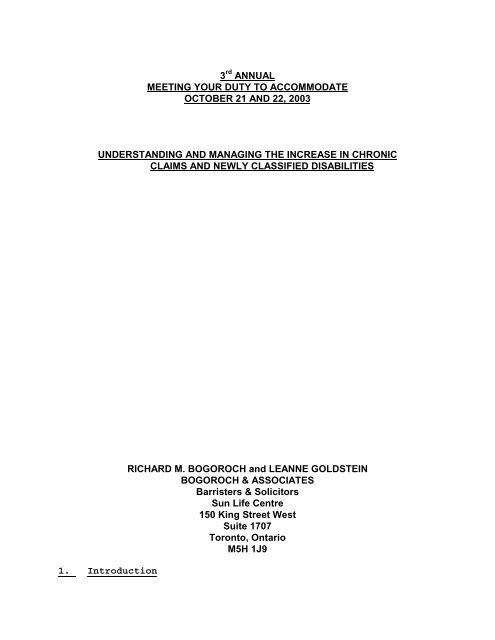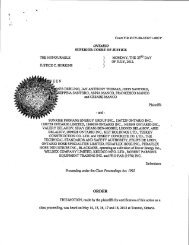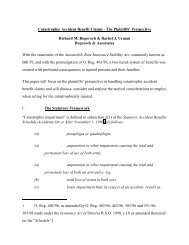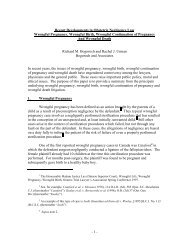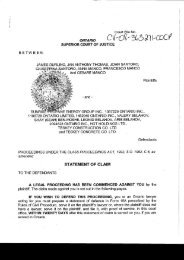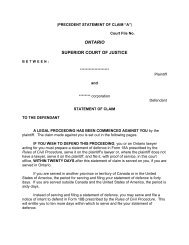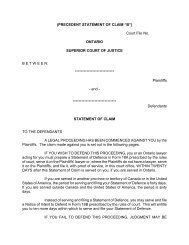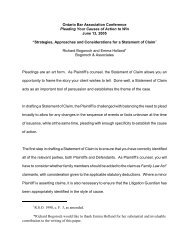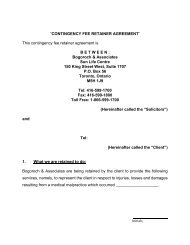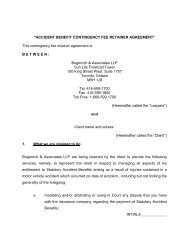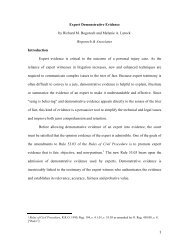Understanding and Managing the Increase in Chronic Claims and ...
Understanding and Managing the Increase in Chronic Claims and ...
Understanding and Managing the Increase in Chronic Claims and ...
Create successful ePaper yourself
Turn your PDF publications into a flip-book with our unique Google optimized e-Paper software.
3 rd ANNUALMEETING YOUR DUTY TO ACCOMMODATEOCTOBER 21 AND 22, 2003UNDERSTANDING AND MANAGING THE INCREASE IN CHRONICCLAIMS AND NEWLY CLASSIFIED DISABILITIES1. IntroductionRICHARD M. BOGOROCH <strong>and</strong> LEANNE GOLDSTEINBOGOROCH & ASSOCIATESBarristers & SolicitorsSun Life Centre150 K<strong>in</strong>g Street WestSuite 1707Toronto, OntarioM5H 1J9
In 1924, Emily Dick<strong>in</strong>son 1 wrote <strong>the</strong> follow<strong>in</strong>g of pa<strong>in</strong>:PAIN has an element of blank;It cannot recollectWhen it began, or if <strong>the</strong>re wereA day when it was not.It has no future but itself,Its <strong>in</strong>f<strong>in</strong>ite realms conta<strong>in</strong>Its past, enlightened to perceiveNew periods of pa<strong>in</strong>.For both medical science <strong>and</strong> <strong>the</strong> legal profession, <strong>the</strong> subject of pa<strong>in</strong> rema<strong>in</strong>s an elusive <strong>and</strong>controversial one. Pa<strong>in</strong> has been def<strong>in</strong>ed by <strong>the</strong> International Association for <strong>the</strong> Study of Pa<strong>in</strong>(“IASP”) 2 as “an unpleasant sensory <strong>and</strong> emotional experience which is primarily associated withtissue damage or described <strong>in</strong> terms of tissue damage, or both”.What can be extrapolated from this def<strong>in</strong>ition is that pa<strong>in</strong> is comprised of both physical <strong>and</strong>emotional components. What complicates th<strong>in</strong>gs fur<strong>the</strong>r, is that <strong>the</strong> perception of pa<strong>in</strong> rema<strong>in</strong>slargely a subjective experience. This poses a difficulty for <strong>the</strong> medical profession when faced with<strong>the</strong> prospect of measur<strong>in</strong>g pa<strong>in</strong> <strong>and</strong> determ<strong>in</strong><strong>in</strong>g its etiology. This, <strong>in</strong> turn, poses a difficulty for those<strong>in</strong> <strong>the</strong> legal profession who rely upon <strong>the</strong>se medical assessments <strong>in</strong> order to determ<strong>in</strong>e causation <strong>and</strong>quantify damages.12Dick<strong>in</strong>son, Emily. The Complete Poems of Emily Dick<strong>in</strong>son. Boston: Little, Brown, 1924;Bartleby.com, 2000.The IASP is an <strong>in</strong>ternational, multidiscipl<strong>in</strong>ary, non-profit professional association dedicated tofur<strong>the</strong>r<strong>in</strong>g research on pa<strong>in</strong> <strong>and</strong> improv<strong>in</strong>g <strong>the</strong> care of patients with pa<strong>in</strong>. It is a Non-GovernmentalOrganization (NGO)<strong>and</strong> an affiliate of <strong>the</strong> World Health Organization (WHO).
−3−Despite <strong>the</strong>se difficulties <strong>and</strong> although <strong>the</strong>re rema<strong>in</strong>s significant controversy, <strong>the</strong>re have beennumerous developments, both <strong>in</strong> medical science <strong>and</strong> <strong>in</strong> our law, <strong>in</strong> <strong>the</strong> form of recogniz<strong>in</strong>g pa<strong>in</strong>associated conditions <strong>and</strong> disorders <strong>and</strong> <strong>the</strong>ir effects on an <strong>in</strong>dividual’s ability to function <strong>in</strong> <strong>the</strong> workplace <strong>and</strong> to perform his or her activities of normal life. Some of <strong>the</strong> pa<strong>in</strong> associated conditions <strong>and</strong>disorders that <strong>the</strong> medical <strong>and</strong> legal profession have grappled with <strong>in</strong> recent years are <strong>Chronic</strong> Pa<strong>in</strong>Syndrome, Fibromyalgia <strong>and</strong> <strong>Chronic</strong> Fatigue Syndrome.2. <strong>Chronic</strong> Pa<strong>in</strong> or <strong>Chronic</strong> Pa<strong>in</strong> SyndromeAcute pa<strong>in</strong>, which is generally regarded as pa<strong>in</strong> that beg<strong>in</strong>s suddenly <strong>and</strong> arises directly from an<strong>in</strong>jury or disease, can be dist<strong>in</strong>guished from chronic pa<strong>in</strong>.The International Association for <strong>the</strong> Study of Pa<strong>in</strong> describes chronic pa<strong>in</strong> as any pa<strong>in</strong> <strong>in</strong> any areaof <strong>the</strong> body that lasts for over a month beyond <strong>the</strong> reasonable or expected recovery time for an <strong>in</strong>juryor disease. O<strong>the</strong>r medical professionals have designated a time l<strong>in</strong>e of three or six months after <strong>the</strong>expected recovery time, <strong>in</strong> classify<strong>in</strong>g whe<strong>the</strong>r pa<strong>in</strong> has developed <strong>in</strong>to chronic pa<strong>in</strong>.Dr. David Corey, <strong>in</strong> his article entitled “<strong>Chronic</strong> Pa<strong>in</strong> Syndrome: Identification <strong>and</strong> Management” 3def<strong>in</strong>es chronic pa<strong>in</strong> as “pa<strong>in</strong> persist<strong>in</strong>g for more than six months from its onset. He fur<strong>the</strong>r exp<strong>and</strong>shis def<strong>in</strong>ition as follows 4 :34Corey, David: <strong>Chronic</strong> Pa<strong>in</strong> Syndrome: Identification <strong>and</strong> Management 1988 9 The Advocates’Quarterly, 223Ibid.
−4−3. The chief compla<strong>in</strong>t is of severe <strong>and</strong> prolonged pa<strong>in</strong> <strong>in</strong> excess of what couldbe expected on <strong>the</strong> basis of organic f<strong>in</strong>d<strong>in</strong>gs.4. At least six of <strong>the</strong> factors listed below are exhibited:(a) Diagnosis of a soft tissue <strong>in</strong>jury;(b) Multiple symptom compla<strong>in</strong>ts, e.g. headaches, fatigue;(c) An unsuccessful attempt to return to work;(d) Guarded movements or avoidance of many activities, e.g. an <strong>in</strong>validlike life-style;(e) Ingestion of multiple analgesics, tranquilizers, etc.(f) Frequent <strong>and</strong> multiple physician contacts;(g) Development of family <strong>and</strong> marital problems;(h) A reduction <strong>in</strong> or loss of libido;(i) Diffuse anger, frustration <strong>and</strong> irritability;(j) Anxiety <strong>and</strong>/or depressive symptoms;(k) Sleep disturbance.”<strong>Chronic</strong> Pa<strong>in</strong> Syndrome is a condition <strong>in</strong> which chronic pa<strong>in</strong> has persisted over a period of time <strong>and</strong>is <strong>in</strong>tense enough that it substantially <strong>in</strong>terferes with a person’s ability to function <strong>and</strong> to carry on hisor her activities of daily liv<strong>in</strong>g. <strong>Chronic</strong> pa<strong>in</strong> erodes <strong>the</strong> sufferer’s confidence, self-esteem, <strong>and</strong>general well-be<strong>in</strong>g. 5 The def<strong>in</strong><strong>in</strong>g feature here is <strong>the</strong> fact that <strong>the</strong> chronic pa<strong>in</strong> has rendered <strong>the</strong> pa<strong>in</strong>sufferer vocationally <strong>and</strong>/or functionally disabled.The difficulty medical professionals have encountered with <strong>Chronic</strong> Pa<strong>in</strong> Syndrome is that it oftenhas what Dr. Manish S<strong>in</strong>gh, an Assistant Professor at Pennsylvania Hahnemann University, hasdescribed as hav<strong>in</strong>g, “a convoluted natural history, unclear etiology <strong>and</strong> often responds poorly tovarious <strong>the</strong>rapies” 6 . Accord<strong>in</strong>g to Dr. S<strong>in</strong>gh, some authors have even stated that <strong>Chronic</strong> Pa<strong>in</strong>Syndrome may be a learned behavioral syndrome. The suggestion is that <strong>the</strong>re may be an <strong>in</strong>itialnoxious56M<strong>in</strong>nesota Board of Medical Practice Update Newsletter, Spr<strong>in</strong>g 1997<strong>Chronic</strong> Pa<strong>in</strong> Syndrome, Manish K. S<strong>in</strong>gh M.D., http://www.e-medic<strong>in</strong>e.com
−5−stimulus that causes pa<strong>in</strong> <strong>and</strong> when <strong>the</strong> pa<strong>in</strong> behaviour is rewarded, that behaviour is re<strong>in</strong>forcedresult<strong>in</strong>g <strong>in</strong> a cont<strong>in</strong>uation of <strong>the</strong> pa<strong>in</strong> behaviour <strong>in</strong> <strong>the</strong> absence of <strong>the</strong> noxious stimulus. 7This may account for <strong>the</strong> belief by certa<strong>in</strong> <strong>in</strong>dividuals <strong>in</strong> <strong>the</strong> medical <strong>and</strong> legal professions that <strong>the</strong>litigation process may <strong>in</strong> fact perpetuate <strong>Chronic</strong> Pa<strong>in</strong> Syndrome.7Ibid.
−6−3. FibromyalgiaThe American College of Rheumatology has provided <strong>the</strong> follow<strong>in</strong>g classification forFibromyalgia 8 :1990 criteria for <strong>the</strong> classification of Fibromyalgia:1. History of widespread pa<strong>in</strong>.Def<strong>in</strong>ition. Pa<strong>in</strong> is considered widespread when all of <strong>the</strong> follow<strong>in</strong>g are present: pa<strong>in</strong> <strong>in</strong><strong>the</strong> left side of <strong>the</strong> body, pa<strong>in</strong> <strong>in</strong> <strong>the</strong> right side of <strong>the</strong> body, pa<strong>in</strong> above <strong>the</strong> waist, <strong>and</strong> pa<strong>in</strong>below <strong>the</strong> waist. In addition, axial skeletal pa<strong>in</strong> (cervical sp<strong>in</strong>e or anterior chest orthoracic sp<strong>in</strong>e or low back) must be present. In this def<strong>in</strong>ition, shoulder <strong>and</strong> buttock pa<strong>in</strong>is considered as pa<strong>in</strong> for each <strong>in</strong>volved side. "Low back" pa<strong>in</strong> is considered lowersegment pa<strong>in</strong>.2. Pa<strong>in</strong> <strong>in</strong> 11 of 18 tender po<strong>in</strong>t sites on digital palpation.For classification purposes, patients will be said to have fibromyalgia if both criteria aresatisfied. Widespread pa<strong>in</strong> must have been present for at least 3 months. The presence ofa second cl<strong>in</strong>ical disorder does not exclude <strong>the</strong> diagnosis of fibromyalgia.4. <strong>Chronic</strong> Fatigue Syndrome /Myalgic EncephalitisThe follow<strong>in</strong>g is <strong>the</strong> case def<strong>in</strong>ition for <strong>Chronic</strong> Fatigue Syndrome as published <strong>in</strong> <strong>the</strong> Annals ofInternal Medic<strong>in</strong>e <strong>in</strong> 1994 9 :89Wolfe F, Smy<strong>the</strong> HA, Yunus MB, Bennett RM, Bombardier C, Goldenberg DL, et al. TheAmerican College of Rheumatology 1990 criteria for <strong>the</strong> classification of fibromyalgia: report of<strong>the</strong> multicenter criteria committee. Arthritis Rheum 1990;33:160---72.Keiji Fukada; Stephen E. Straus; Ian Hickie; Michael C. Sharpe; James G. Dobb<strong>in</strong>s; <strong>and</strong> AnthonyKomatroff, International <strong>Chronic</strong> Fatigue Syndrome Study Group, 15 December 1994, Volume121, Issue 12, Pages 953-959.
−7−Fatigue:Patients must have o<strong>the</strong>rwise unexpla<strong>in</strong>ed, relaps<strong>in</strong>g fatigue that is new (not lifelong);not <strong>the</strong> result of ongo<strong>in</strong>g exertion; not relieved by rest; <strong>and</strong> that results <strong>in</strong>substantial decreases <strong>in</strong> levels of occupational, social, educational, or personalactivities.Symptoms:The patient must have four or more of <strong>the</strong> follow<strong>in</strong>g eight symptoms. Symptomsmust persist for six months <strong>and</strong> <strong>the</strong> patient must not have predated fatigue.1. Self-reported impairment of memory or concentration that affectsoccupational, social, educational, or personal activities.2. Sore throat.3. Tender cervical (neck area) or axillary (underarm area) nodes.4. Myalgias (muscle pa<strong>in</strong>).5. Arthralgias (pa<strong>in</strong> along <strong>the</strong> nerve of <strong>the</strong> jo<strong>in</strong>t). No redness or swell<strong>in</strong>g.6. Headache of a new type.7. Unrefresh<strong>in</strong>g sleep.8. Post-exertional malaise, last<strong>in</strong>g more than one day.5. Differ<strong>in</strong>g PerspectivesAt a Cont<strong>in</strong>u<strong>in</strong>g Legal Education conference organized by <strong>the</strong> Advocates Society of Ontario onJanuary 12 <strong>and</strong> January 13, 1996 10 , various medical experts from differ<strong>in</strong>g fields were asked toprovide <strong>the</strong>ir views on <strong>the</strong> recognition, treatment <strong>and</strong> management of <strong>Chronic</strong> Pa<strong>in</strong> <strong>and</strong>Fibromyalgia.Lead<strong>in</strong>g neurologists, psychiatrists, rhematologists, orthopedic surgeons <strong>and</strong> physiatrists provided<strong>the</strong>ir cl<strong>in</strong>ical perspectives on <strong>Chronic</strong> Pa<strong>in</strong> <strong>and</strong> Fibromyalgia <strong>and</strong> were asked to comment, <strong>in</strong>particular, upon <strong>the</strong> difficulties of ‘prov<strong>in</strong>g <strong>and</strong> quantify<strong>in</strong>g’ <strong>Chronic</strong> Pa<strong>in</strong> <strong>and</strong> Fibromyalgia.10"Practical Strategies for Advocates V" ( 1996 ) <strong>Underst<strong>and</strong><strong>in</strong>g</strong> <strong>Chronic</strong> Pa<strong>in</strong>, The AdvocatesSociety of Ontario, January 12-13, 1996
−8−The differ<strong>in</strong>g perspectives presented by <strong>the</strong> various experts at <strong>the</strong> conference substantiated <strong>the</strong> viewof many of <strong>the</strong> experts that <strong>Chronic</strong> Pa<strong>in</strong> <strong>and</strong> Fibromyalgia are complex <strong>and</strong> controversial areas.Many of <strong>the</strong> experts also stated that while <strong>the</strong>re cont<strong>in</strong>ue to be those <strong>in</strong>dividuals who rema<strong>in</strong>skeptical of <strong>the</strong> existence of <strong>the</strong>se conditions, <strong>the</strong>re are a number of specialities that have begun torecognize <strong>the</strong>se conditions <strong>and</strong> are attempt<strong>in</strong>g to develop strategies to measure <strong>and</strong> assess <strong>the</strong>conditions <strong>and</strong> <strong>the</strong>ir effect on a sufferer’s function<strong>in</strong>g <strong>in</strong> <strong>the</strong> work environment <strong>and</strong> <strong>in</strong> daily life.As well, many of <strong>the</strong> experts noted that because of <strong>the</strong> multiplicity of factors, both physiological <strong>and</strong>emotional, associated with <strong>the</strong>se conditions, an multi-discipl<strong>in</strong>ary approach is called for.6. Implications for LitigationThe grow<strong>in</strong>g recognition of <strong>the</strong>se conditions <strong>in</strong> <strong>the</strong> medical community <strong>and</strong> <strong>the</strong> multi-discipl<strong>in</strong>aryapproach advocated has implications <strong>in</strong> <strong>the</strong> legal realm.In general, <strong>Chronic</strong> Pa<strong>in</strong>, Fibromyalgia <strong>and</strong> <strong>Chronic</strong> Fatigue Syndrome cases, whe<strong>the</strong>r <strong>in</strong> <strong>the</strong> contextof a tort action, accident benefits claim or long-term disability action, are difficult cases <strong>and</strong> presentunique challenges. This is not only because of <strong>the</strong> complexities of <strong>the</strong>se medical conditions butbecause of <strong>the</strong> need to expla<strong>in</strong> how a seem<strong>in</strong>gly <strong>in</strong>nocuous <strong>in</strong>jury can result <strong>in</strong> a Pla<strong>in</strong>tiff becom<strong>in</strong>gvocationally <strong>and</strong>/or functionally disabled.As <strong>in</strong> any personal <strong>in</strong>jury action, <strong>in</strong> <strong>Chronic</strong> Pa<strong>in</strong>, Fibromyalgia <strong>and</strong> <strong>Chronic</strong> Fatigue Syndromecases, it is necessary to marshall <strong>the</strong> appropriate expert evidence <strong>in</strong> order to provide <strong>the</strong> trier of factwith a medical framework <strong>and</strong> a greater underst<strong>and</strong><strong>in</strong>g of <strong>the</strong> Pla<strong>in</strong>tiff’s medical condition <strong>and</strong> howthat condition affects <strong>the</strong> Pla<strong>in</strong>tiff’s life.
−9−The divergence of medical op<strong>in</strong>ions with respect to <strong>Chronic</strong> Pa<strong>in</strong>, Fibromyalgia <strong>and</strong> <strong>Chronic</strong> FatigueSyndrome renders <strong>the</strong> task of demonstrat<strong>in</strong>g <strong>the</strong> Pla<strong>in</strong>tiff’s medical condition <strong>and</strong> vocational <strong>and</strong>/orfunctional limitations to <strong>the</strong> trier of fact, all <strong>the</strong> more challeng<strong>in</strong>g.It is useful <strong>the</strong>refore to approach <strong>the</strong> matter from a “multi-discipl<strong>in</strong>ary perspective”, utiliz<strong>in</strong>g <strong>the</strong>evidence of various experts <strong>in</strong> appropriate fields to provide a well-rounded assessment of <strong>the</strong>Pla<strong>in</strong>tiff’s condition <strong>and</strong> attendant limitations.It also is important to ensure that <strong>the</strong> right experts are selected. The experts selected should not onlybe competent <strong>and</strong> experienced <strong>in</strong> <strong>the</strong>ir field of practice, but should be experts who are respected for<strong>the</strong>ir objectivity <strong>and</strong> ability to render <strong>in</strong>dependent <strong>and</strong> unbiased op<strong>in</strong>ions. Experts should be ableto fulfill <strong>the</strong>ir primary role, which is to assist <strong>the</strong> trier of fact <strong>and</strong> should not fall <strong>in</strong>to <strong>the</strong> trap ofadvocat<strong>in</strong>g for a particular position.The role of <strong>the</strong> expert <strong>in</strong> this regard was discussed <strong>in</strong> Toronto-Dom<strong>in</strong>ion Bank v. E. GoldbergerHold<strong>in</strong>gs Ltd 11 ., <strong>in</strong> which <strong>the</strong> Court stated that :[E]xperts must conduct <strong>the</strong>mselves as objective neutral assisters of <strong>the</strong> court <strong>and</strong>, if<strong>the</strong>y fail to fulfill this function, <strong>the</strong>ir testimony should be ruled <strong>in</strong>admissible <strong>and</strong><strong>the</strong>refore ignored after <strong>the</strong>y have been eviscerated.This is particularly important <strong>in</strong> <strong>Chronic</strong> Pa<strong>in</strong>, Fibromyalgia <strong>and</strong> <strong>Chronic</strong> Fatigue Syndrome caseswhere <strong>the</strong>re is a proliferation of medical op<strong>in</strong>ions as to <strong>the</strong> cause <strong>and</strong> effect of <strong>the</strong>se conditions <strong>and</strong><strong>the</strong>ir implications on vocational <strong>and</strong> functional ability.The role of Pla<strong>in</strong>tiff’s counsel does not end with choos<strong>in</strong>g <strong>the</strong> right expert. Pla<strong>in</strong>tiff’s counsel must11Toronto-Dom<strong>in</strong>ion Bank v. E. Goldberger Hold<strong>in</strong>gs Ltd. [1999] O.J. No. 5324
−10−ensure that <strong>the</strong> expert is provided with all necessary arsenal <strong>in</strong> <strong>the</strong> form of medical reports <strong>and</strong>cl<strong>in</strong>ical notes <strong>and</strong> records obta<strong>in</strong>ed from <strong>the</strong> Pla<strong>in</strong>tiff’s treat<strong>in</strong>g medical practitioners. The complexnature of <strong>Chronic</strong> Pa<strong>in</strong>, Fibromyalgia <strong>and</strong> <strong>Chronic</strong> Fatigue Syndrome makes it essential that anaccurate medical history is obta<strong>in</strong>ed <strong>and</strong> provided to <strong>the</strong> expert. It is useful to provide <strong>the</strong> expert withhistorical medical records, usually between three to five years prior to <strong>the</strong> trigger<strong>in</strong>g <strong>in</strong>cident (if thiscan be ascerta<strong>in</strong>ed), <strong>in</strong> order to create a more accurate picture of <strong>the</strong> Pla<strong>in</strong>tiff’s medical condition.It is also crucial that <strong>the</strong> medical expert be provided with copies of defence medical reports orassessments performed at <strong>the</strong> request of an <strong>in</strong>surance company so that <strong>the</strong> expert can review <strong>and</strong>comment upon <strong>the</strong> differ<strong>in</strong>g op<strong>in</strong>ions rendered.The role of <strong>the</strong> expert is an essential one <strong>and</strong> it is vital that <strong>the</strong> expert is placed <strong>in</strong> <strong>the</strong> best positionto comment upon <strong>the</strong> Pla<strong>in</strong>tiff’s condition.7. CredibilityOne of <strong>the</strong> difficulties with <strong>Chronic</strong> Pa<strong>in</strong>, Fibromyalgia <strong>and</strong> <strong>Chronic</strong> Fatigue Syndrome is that <strong>the</strong>seconditions are primarily associated with pa<strong>in</strong> which, as stated previously, is a subjective experience<strong>and</strong> difficult to measure on an objective level.Although <strong>the</strong>re have been a number of tests developed to measure pa<strong>in</strong>, <strong>the</strong>se tests generally require<strong>the</strong> pa<strong>in</strong> sufferer to rate pa<strong>in</strong> <strong>and</strong> difficulty on a subjective level. As a result, <strong>the</strong> credibility of <strong>the</strong>Pla<strong>in</strong>tiff becomes a vital component <strong>in</strong> <strong>Chronic</strong> Pa<strong>in</strong>, Fibromyalgia <strong>and</strong> <strong>Chronic</strong> Fatigue Syndromecases.
−11−The Pla<strong>in</strong>tiff’s credibility can be established <strong>in</strong> various ways. Lay witness accounts from family,friends <strong>and</strong> colleagues compar<strong>in</strong>g <strong>the</strong> Pla<strong>in</strong>tiff’s pre- <strong>and</strong> post-accident conditions <strong>and</strong> <strong>the</strong> veracityof <strong>the</strong> Pla<strong>in</strong>tiff’s pa<strong>in</strong> compla<strong>in</strong>ts as evidenced by pa<strong>in</strong> behaviours, can be used to establishcredibility.The consistency of <strong>the</strong> Pla<strong>in</strong>tiff’s compla<strong>in</strong>ts to his or her treat<strong>in</strong>g doctors <strong>and</strong> <strong>the</strong> depiction of <strong>the</strong>Pla<strong>in</strong>tiff as an honest <strong>and</strong> forthright <strong>in</strong>dividual with respect to his or her medical history can also beused to bolster <strong>the</strong> Pla<strong>in</strong>tiff’s credibility.The issue of surveillance is also relevant to credibility. Surveillance is often conducted on Pla<strong>in</strong>tiffswho suffer from <strong>Chronic</strong> Pa<strong>in</strong>, Fibromyalgia or <strong>Chronic</strong> Fatigue Syndrome aris<strong>in</strong>g out of an accidentor <strong>in</strong>jury. The only truly detrimental surveillance is when <strong>the</strong>re is stark contrast between what <strong>the</strong>Pla<strong>in</strong>tiff states he or she is able to do <strong>and</strong> what is captured <strong>in</strong> <strong>the</strong> course of surveillance. Even <strong>the</strong>n,surveillance often fails to capture certa<strong>in</strong> pa<strong>in</strong> behaviours <strong>and</strong> facial expressions which may be <strong>the</strong>only <strong>in</strong>dication that an <strong>in</strong>dividual is suffer<strong>in</strong>g from pa<strong>in</strong>.8. How our Legal System has dealt with <strong>Chronic</strong> Pa<strong>in</strong>, Fibromyalgia <strong>and</strong> <strong>Chronic</strong> FatigueSyndromeThe challenges experienced by <strong>the</strong> medical profession <strong>in</strong> deal<strong>in</strong>g with <strong>Chronic</strong> Pa<strong>in</strong>, Fibromyalgia<strong>and</strong> <strong>Chronic</strong> Fatigue Syndrome are reflected <strong>in</strong> <strong>the</strong> decisions of our judges <strong>and</strong> arbitrators.In Makie v. Wolfe 12 Madam Justice Rawl<strong>in</strong>s commented upon evidence presented by Dr. McCa<strong>in</strong>,an expert rhematologist, <strong>and</strong> stated that:12Makie v. Wolfe, (1994) 153 A.R. 81, 21 Alta. L.R. (3d) 11
−12−Dr. McCa<strong>in</strong> admitted that <strong>the</strong>re is no known cause of Fibromyalgia <strong>and</strong> by that Iassume he meant physical cause. At best, all he could accurately say was that <strong>the</strong>rewere several <strong>the</strong>ories of causation that were prevalent.In Thompson v. Ballantyne 13 , <strong>the</strong> Pla<strong>in</strong>tiff was diagnosed with fibromyalgia follow<strong>in</strong>g a motorvehicle accident. A motion was brought by <strong>the</strong> Defendants to dismiss <strong>the</strong> Pla<strong>in</strong>tiff’s claim on <strong>the</strong>basis that <strong>the</strong> Pla<strong>in</strong>tiff had failed to br<strong>in</strong>g herself with<strong>in</strong> <strong>the</strong> exemptions aris<strong>in</strong>g from <strong>the</strong> statutorybar to actions for personal <strong>in</strong>juries suffered <strong>in</strong> a car accident. The Defendants argued thatfibromyalgia was not a physical disease but a psychological one <strong>and</strong> accord<strong>in</strong>gly, <strong>the</strong> Pla<strong>in</strong>tiff wasnot exempt from <strong>the</strong> bar to actions for personal <strong>in</strong>juries. The court held that, on a balance ofprobabilities, <strong>the</strong> Pla<strong>in</strong>tiff suffered from fibromyalgia, which <strong>the</strong> court viewed as a physical disease.In Jones v. Prudential Group Assurance Co. of Engl<strong>and</strong> (Canada) 14 , Cus<strong>in</strong>ato J. commented upon<strong>the</strong> expert evidence presented <strong>and</strong> stated that “Fibromyalgia is classified as a syndrome, becausescience has not yet perfected an objective diagnosis for <strong>the</strong> disease”.In Swa<strong>in</strong> v. Moore Estate 15 , <strong>the</strong> Pla<strong>in</strong>tiff suffered from extensive soft tissue <strong>in</strong>juries, chronic pa<strong>in</strong>,post-traumatic stress, fibromyalgia, anxiety <strong>and</strong> depression as a result of a motor vehicle accident.Her husb<strong>and</strong>, daughter <strong>and</strong> son asserted Family Law Act claims. After <strong>the</strong> accident, <strong>the</strong> Pla<strong>in</strong>tiff haddifficulty cop<strong>in</strong>g with her daily life. She had tried work<strong>in</strong>g <strong>in</strong> <strong>the</strong> family bus<strong>in</strong>ess but was unable toh<strong>and</strong>le <strong>the</strong> pressure. Justice Patterson concluded that her <strong>in</strong>juries were catastrophic <strong>and</strong> that she wastotally disabled. Her damages were assessed at $100,000.00; $15,000.00 was awarded to husb<strong>and</strong>;$10,000.00 to her daughter <strong>and</strong> $5,000.00 to her son.131415Thompson v. Ballantyne [1996] O.J. No. 4856 (Ont. Gen. Div.)Jones v. Prudential Group Assurance Co. of Engl<strong>and</strong> (Canada), [1999] O.J. No. 2862, atparagraph 72Swa<strong>in</strong> v. Moore Estate [2000] O.J. No. 1628
−13−In Kuhne v. M<strong>in</strong>ife 16 , a decision of <strong>the</strong> British Columbia Supreme Court, <strong>the</strong> Pla<strong>in</strong>tiff suffered fromfibromyalgia as a result of a motor vehicle accident <strong>and</strong> was no longer able to work. After prov<strong>in</strong>gthat her fibromyalgia was caused by <strong>the</strong> motor vehicle accident, <strong>the</strong> Pla<strong>in</strong>tiff was awarded generaldamages <strong>in</strong> <strong>the</strong> amount of $85,000.00.16Kuhne v. M<strong>in</strong>ifie, [2001] B.C. J. No. 287 (B.C.S.C.)
−14−In Pisciotto v. CAA Insurance Co. (Ontario) 17 , Justice Thomson discusses fibromyalgia syndrome<strong>and</strong> <strong>the</strong> evidence presented by <strong>the</strong> expert witnesses for <strong>the</strong> parties. He <strong>the</strong>n comments at paragraph127 of his judgement that “<strong>the</strong>re appears to be some debate <strong>in</strong> <strong>the</strong> medical community <strong>and</strong> amongexperts who were <strong>in</strong>volved <strong>in</strong> this case regard<strong>in</strong>g <strong>the</strong> existence of fibromylagia as a bona fidemedical condition”. 18Thomson J. goes on to state at paragraphs 140 <strong>and</strong> 141 as follows 19 :Clearly test<strong>in</strong>g for fibromyalgia is subjective because it depends on what <strong>the</strong> patienttells <strong>the</strong> doctor. Secondly, it <strong>the</strong>n seems to be a mixture of subjective <strong>and</strong> objectivewhen <strong>the</strong> patients respond or do not respond to palpitation of <strong>the</strong> tender <strong>and</strong> controlpo<strong>in</strong>ts. It seems to me that if a patient has basic knowledge of <strong>the</strong> trigger <strong>and</strong> controlpo<strong>in</strong>ts palpation tests because of <strong>the</strong> number of times <strong>the</strong> palpat<strong>in</strong>g has been done orbecause <strong>the</strong>y have learned all about <strong>the</strong>se po<strong>in</strong>ts from pr<strong>in</strong>ted <strong>in</strong>formation, <strong>the</strong>n it isopen for a trier of fact to conclude <strong>the</strong> tests were susceptible to manipulation <strong>and</strong>unreliable. The diagnosis may <strong>the</strong>n be <strong>in</strong>accurate.Thus, <strong>the</strong> reliability of any medical diagnosis <strong>and</strong> prognosis depends almost entirelyon <strong>the</strong> reliability, believability or credibility of what <strong>the</strong> patient tells <strong>the</strong> physician<strong>and</strong> what <strong>the</strong> physician learns from palpat<strong>in</strong>g.Justice Thomson goes on to discuss <strong>the</strong> Pla<strong>in</strong>tiff’s credibility <strong>and</strong> comments that he has gravereservations about <strong>the</strong> validity of <strong>the</strong> fibromyalgia diagnosis <strong>and</strong> <strong>the</strong> degree of pa<strong>in</strong> <strong>and</strong> physicaldisability <strong>the</strong> Pla<strong>in</strong>tiff said she suffered from <strong>the</strong> date of <strong>the</strong> accident.171819Pisciotto v. CAA Insurance Co. (Ontario), [2000] O.J. No. 2995Ibid.Ibid.
−15−Justice Thomson ultimately concludes that he is not satisfied on a balance of probabilities that <strong>the</strong>Pla<strong>in</strong>tiff suffered an <strong>in</strong>jury <strong>in</strong> <strong>the</strong> motor vehicle accident that cont<strong>in</strong>uously prevented her fromengag<strong>in</strong>g <strong>in</strong> any employment for which she was reasonably suited by education, tra<strong>in</strong><strong>in</strong>g orexperience.This decision, <strong>in</strong> particular, reflects some of <strong>the</strong> difficulties that our courts have had with <strong>Chronic</strong>Pa<strong>in</strong>, Fibromyalgia <strong>and</strong> <strong>Chronic</strong> Fatigue Syndrome cases.The issue of <strong>Chronic</strong> Pa<strong>in</strong> was dealt with differently by Arbitrator Makepeace <strong>in</strong> <strong>the</strong> F<strong>in</strong>ancialServices Commission of Ontario decision of Quattrocchi v. State Farm 20 . In Quattrocchi,Arbitrator Makepeace reviewed various arbitration decisions <strong>and</strong> enunciated some general pr<strong>in</strong>ciplesthat have emerged from <strong>the</strong>se decisions, <strong>in</strong>clud<strong>in</strong>g <strong>the</strong> follow<strong>in</strong>g:(i)(j)(k)Where <strong>the</strong>re is no objective evidence of impairment, or <strong>the</strong> objective evidence does notexpla<strong>in</strong> <strong>the</strong> degree of pa<strong>in</strong> reported by <strong>the</strong> <strong>in</strong>sured person, <strong>the</strong> <strong>in</strong>sured’s credibility becomesimportant. In assess<strong>in</strong>g <strong>the</strong> <strong>in</strong>sured person’s subjective pa<strong>in</strong> compla<strong>in</strong>ts, Arbitrators considerall of <strong>the</strong> circumstances, <strong>in</strong>clud<strong>in</strong>g <strong>the</strong> consistency of <strong>the</strong> <strong>in</strong>sured person’s compla<strong>in</strong>ts <strong>and</strong>apparent functional level.In order to prove entitlement to weekly benefits, an <strong>in</strong>sured must show that his or herdisability resulted from <strong>the</strong> accident. Arbitrators have consistently said that <strong>the</strong> accident neednot be <strong>the</strong> only cause of <strong>the</strong> <strong>in</strong>sured’s problems, but must be a significant or materialcontribut<strong>in</strong>g factor. Accord<strong>in</strong>gly, even if <strong>the</strong> Applicant’s own attitudes or <strong>in</strong>action havedelayed his or her recovery, he or she may still be entitled to benefits, if <strong>the</strong> accident rema<strong>in</strong>s<strong>the</strong> more significant factor.It is not sufficient to dismiss a chronic pa<strong>in</strong> claim on <strong>the</strong> basis that return<strong>in</strong>g to work wouldnot harm <strong>the</strong> applicant.20Quattrocchi <strong>and</strong> State Farm Mutual Automobile Insurance Co. (OIC A-006854), September 29,1997)
−16−Some of <strong>the</strong> pr<strong>in</strong>ciples elucidated <strong>in</strong> <strong>the</strong> Quattrocchi decision have been applied <strong>in</strong> o<strong>the</strong>r decisions 21where claimants have been diagnosed with <strong>Chronic</strong> Pa<strong>in</strong> or Fibromyalgia subsequent to a motorvehicle accident.In <strong>the</strong> realm of workers’ compensation benefits, <strong>the</strong>re have been significant strides with respectto recogniz<strong>in</strong>g claims made by workers disabled by <strong>Chronic</strong> Pa<strong>in</strong>.21Elham Raymond <strong>and</strong> Halifax Insuarance Company (FSCO- A97-001629), March 8, 1999
−17−In <strong>the</strong> recent decision of Nova Scotia (Worker’s Compensation Board) v. Mart<strong>in</strong> 22 , <strong>the</strong> SupremeCourt of Canada ruled that <strong>the</strong> exclusion of persons disabled by chronic pa<strong>in</strong> from <strong>the</strong> usual worker’scompensation scheme violates s.15(1) of <strong>the</strong> Canadian Charter of Rights <strong>and</strong> Freedoms (<strong>the</strong> equalityprovision) 23 .The specific provision before <strong>the</strong> court was s.10 of <strong>the</strong> Nova Scotia Worker’s Compensation Act,S.N.S. 1994-95, c. 10, as amended, which denied full benefits to workers with chronic pa<strong>in</strong> <strong>and</strong> onlypermitted access to limited benefits.In <strong>the</strong> <strong>in</strong>troduction to his decision, Justice Charles Gonthier writes:<strong>Chronic</strong> pa<strong>in</strong> syndrome <strong>and</strong> related medical conditions have emerged <strong>in</strong> recent yearsas one of <strong>the</strong> most difficult problems fac<strong>in</strong>g workers' compensation schemes <strong>in</strong>Canada <strong>and</strong> around <strong>the</strong> world. There is no authoritative def<strong>in</strong>ition of chronic pa<strong>in</strong>. Itis, however, generally considered to be pa<strong>in</strong> that persists beyond <strong>the</strong> normal heal<strong>in</strong>gtime for <strong>the</strong> underly<strong>in</strong>g <strong>in</strong>jury or is disproportionate to such <strong>in</strong>jury, <strong>and</strong> whoseexistence is not supported by objective f<strong>in</strong>d<strong>in</strong>gs at <strong>the</strong> site of <strong>the</strong> <strong>in</strong>jury under current2223Nova Scotia (Worker’s Compensation Board) v. Mart<strong>in</strong>, [2003] S.C.J. No. 54S. 15, Canadian Charter of Rights <strong>and</strong> Freedoms, Constitution Act, 1982 (79),Enacted asSchedule B to <strong>the</strong> Canada Act 1982 (U.K.) 1982, c. 11, which came <strong>in</strong>to force on April 17, 1982
−18−medical techniques. Despite this lack of objective f<strong>in</strong>d<strong>in</strong>gs, <strong>the</strong>re is no doubt thatchronic pa<strong>in</strong> patients are suffer<strong>in</strong>g <strong>and</strong> <strong>in</strong> distress, <strong>and</strong> that <strong>the</strong> disability <strong>the</strong>yexperience is real. While <strong>the</strong>re is at this time no clear explanation for chronic pa<strong>in</strong>,recent work on <strong>the</strong> nervous system suggests that it may result from pathologicalchanges <strong>in</strong> <strong>the</strong> nervous mechanisms that result <strong>in</strong> pa<strong>in</strong> cont<strong>in</strong>u<strong>in</strong>g <strong>and</strong> non-pa<strong>in</strong>fulstimuli be<strong>in</strong>g perceived as pa<strong>in</strong>ful. These changes, it is believed, may be precipitatedby peripheral events, such as an accident, but may persist well beyond <strong>the</strong> normalrecovery time for <strong>the</strong> precipitat<strong>in</strong>g event. Despite this reality, s<strong>in</strong>ce chronic pa<strong>in</strong>sufferers are impaired by a condition that cannot be supported by objective f<strong>in</strong>d<strong>in</strong>gs,<strong>the</strong>y have been subjected to persistent suspicions of mal<strong>in</strong>ger<strong>in</strong>g on <strong>the</strong> part ofemployers, compensation officials <strong>and</strong> even physicians.This decision represents a clear recognition of <strong>the</strong> disability that can be experienced by <strong>in</strong>dividualssuffer<strong>in</strong>g from chronic pa<strong>in</strong> <strong>and</strong> as such, constitutes a positive step for those who may be seek<strong>in</strong>gcompensation as a result of <strong>the</strong>ir disabilities.9. The Response of InsurersInsurers faced with claims from <strong>in</strong>dividuals diagnosed as suffer<strong>in</strong>g from <strong>Chronic</strong> Pa<strong>in</strong>, Fibromyalgiaor <strong>Chronic</strong> Fatigue Syndrome aris<strong>in</strong>g out of a motor vehicle accident or o<strong>the</strong>r <strong>in</strong>jury, or thoseclaim<strong>in</strong>g disability benefits as result of <strong>the</strong>se conditions, should not immediately dismiss <strong>the</strong>seclaims.In order to avoid claims for bad faith, <strong>in</strong>surers must ensure that claims are h<strong>and</strong>led promptly <strong>and</strong> thatrelevant medical reports are obta<strong>in</strong>ed <strong>and</strong> carefully reviewed. Insurers should write to <strong>the</strong> claimant’streat<strong>in</strong>g doctors before any decision is made to term<strong>in</strong>ate benefits <strong>and</strong> <strong>the</strong> op<strong>in</strong>ions of <strong>the</strong> treat<strong>in</strong>gdoctors should be carefully considered by <strong>the</strong> <strong>in</strong>surer.
−19−If appropriate, <strong>the</strong> <strong>in</strong>surer should arrange for relevant medical experts to assess <strong>the</strong> claimant <strong>and</strong>comment on <strong>the</strong> nature of <strong>the</strong> claimant’s medical condition <strong>and</strong> how that condition affects <strong>the</strong>claimant’s vocational <strong>and</strong>/or functional abilities. A job site analysis is often useful <strong>in</strong> this regard as<strong>the</strong> analysis will establish <strong>the</strong> parameters with<strong>in</strong> which <strong>the</strong> claimant’s disabilities can be analyzed.A decision deny<strong>in</strong>g or term<strong>in</strong>at<strong>in</strong>g benefits based upon medical reports that merely dismiss <strong>the</strong>claimant’s compla<strong>in</strong>ts because <strong>the</strong>se compla<strong>in</strong>ts are not supported by objective f<strong>in</strong>d<strong>in</strong>gs, may besubject to serious scrut<strong>in</strong>y at a later date.Fail<strong>in</strong>g to properly <strong>in</strong>vestigate <strong>the</strong> claimant’s medial condition <strong>and</strong> disabilities could potentiallyexpose <strong>the</strong> <strong>in</strong>surer to a claim for bad faith, particularly where all of <strong>the</strong> claimant’s treat<strong>in</strong>gpractitioners are attest<strong>in</strong>g to <strong>the</strong> claimant’s extensive disabilities <strong>and</strong> functional limitations <strong>and</strong> <strong>the</strong><strong>in</strong>surer has not obta<strong>in</strong>ed any contradictory medical reports <strong>in</strong> this regard.In light of <strong>the</strong> grow<strong>in</strong>g recognition of <strong>Chronic</strong> Pa<strong>in</strong>, Fibromyalgia, <strong>Chronic</strong> Fatigue Syndrome <strong>and</strong>o<strong>the</strong>r pa<strong>in</strong>- associated conditions <strong>and</strong> <strong>the</strong>ir potentially disabl<strong>in</strong>g effects, <strong>in</strong>surers should be preparedto resolve <strong>the</strong>se types of cases for realistic values.If <strong>the</strong> accident or <strong>in</strong>jury has rendered <strong>the</strong> Pla<strong>in</strong>tiff unemployable or unable to return to his or herprevious employment, <strong>the</strong> Pla<strong>in</strong>tiff, depend<strong>in</strong>g on <strong>the</strong> nature of his or her employment, couldpotentially be awarded significant damages. Fur<strong>the</strong>rmore, depend<strong>in</strong>g on <strong>the</strong> extent of <strong>the</strong> Pla<strong>in</strong>tiff’sdisability, <strong>the</strong>re may be a significant award for <strong>the</strong> cost of future care.
−20−Accord<strong>in</strong>gly, when participat<strong>in</strong>g <strong>in</strong> a mediation, an <strong>in</strong>surer should ensure that <strong>the</strong> necessary<strong>in</strong>vestigations have been conducted <strong>and</strong> that sufficient medical <strong>in</strong>formation <strong>and</strong> documentation hasbeen obta<strong>in</strong>ed with respect to <strong>the</strong> claimant’s medical condition <strong>and</strong> attendant disabilities.Our judges <strong>and</strong> judges have <strong>and</strong> cont<strong>in</strong>ue to award aggravated <strong>and</strong>/or punitive damages <strong>and</strong> specialawards where an <strong>in</strong>surer has acted <strong>in</strong> bad faith <strong>and</strong> failed to properly <strong>in</strong>vestigate <strong>and</strong> consider aclaim.In Clarfield v. Crown Life Insurance Co. 24 , <strong>the</strong> Pla<strong>in</strong>tiff claimed aga<strong>in</strong>st Crown Life Insurance forpayment of disability benefits pursuant to an <strong>in</strong>surance policy. The Pla<strong>in</strong>tiff also claimed aggravated<strong>and</strong> punitive damages. Justice Juriansz awarded <strong>the</strong> Pla<strong>in</strong>tiff benefits under <strong>the</strong> policy of <strong>in</strong>suranceon <strong>the</strong> basis that <strong>the</strong> Pla<strong>in</strong>tiff was totally disabled with<strong>in</strong> <strong>the</strong> mean<strong>in</strong>g of <strong>the</strong> policy until hecommenced a tra<strong>in</strong><strong>in</strong>g program. Justice Jurianz also awarded aggravated damages <strong>in</strong> <strong>the</strong> amount of$75,000.00 <strong>and</strong> punitive damages <strong>in</strong> <strong>the</strong> amount of $200,000.00, comment<strong>in</strong>g that <strong>the</strong> <strong>in</strong>surer hadfailed to assess <strong>the</strong> Pla<strong>in</strong>tiff’s claim <strong>in</strong> a balanced <strong>and</strong> reasonable manner <strong>and</strong> had failed to act fairly<strong>and</strong> promptly when it dealt with <strong>the</strong> Pla<strong>in</strong>tiff’s claim.The failure of an <strong>in</strong>surer to act <strong>in</strong> good faith was also addressed <strong>in</strong> Whiten v. Pilot Insurance Co. 25In that case, a fire completely destroyed <strong>the</strong> <strong>in</strong>sured’s home <strong>and</strong> its contents. Although <strong>the</strong> <strong>in</strong>surer<strong>in</strong>itially paid $5000.00 <strong>in</strong> liv<strong>in</strong>g expenses <strong>and</strong> <strong>the</strong> family’s rent for a couple of months, <strong>the</strong> <strong>in</strong>surercut off rent abruptly without notice <strong>and</strong> refused to make fur<strong>the</strong>r payments alleg<strong>in</strong>g that <strong>the</strong> familyhad <strong>in</strong>tentionally set fire to <strong>the</strong>ir home. The Supreme Court of Canada held that <strong>the</strong> jury’s award ofpunitive damages <strong>in</strong> <strong>the</strong> amount of $1 million was with<strong>in</strong> rational limits given that <strong>the</strong> <strong>in</strong>surer’sconduct was exceptionally reprehensible <strong>and</strong> gave rise to an actionable wrong <strong>in</strong> addition to <strong>the</strong>breach sued upon.2425Clarfield v. Crown Life Insurance Co. [2000] O.J. No. 4074 (S.C.J.)Whiten v. Pilot Insurance Co. [2002] S.C.J. No. 19 (S.C.C.)
−21−In Fimiani <strong>and</strong> Liberty Mutual Insurance Company 26 , a decision of <strong>the</strong> F<strong>in</strong>ancial ServicesCommission of Ontario, <strong>the</strong> <strong>in</strong>surer was liable to pay a special award based on its failure to accept<strong>the</strong> existence of <strong>the</strong> Pla<strong>in</strong>tiff’s chronic pa<strong>in</strong> condition <strong>and</strong> based upon its unreasonable conduct <strong>in</strong>withhold<strong>in</strong>g benefits.10. ConclusionAlthough <strong>the</strong> subject of pa<strong>in</strong> rema<strong>in</strong>s an elusive <strong>and</strong> controversial one, <strong>the</strong>re has been a grow<strong>in</strong>grecognition <strong>in</strong> recent years of pa<strong>in</strong>-associated conditions such as <strong>Chronic</strong> Pa<strong>in</strong>, Fibromyalgia <strong>and</strong><strong>Chronic</strong> Fatigue Syndrome, which may develop as a result of <strong>the</strong> claimant’s <strong>in</strong>volvement <strong>in</strong> anaccident or as a result of an <strong>in</strong>jury.As a result, rely<strong>in</strong>g too heavily on reports that merely dismiss <strong>the</strong> claimant’s compla<strong>in</strong>ts because<strong>the</strong>se compla<strong>in</strong>ts are not supported by objective f<strong>in</strong>d<strong>in</strong>gs, may prove detrimental at <strong>the</strong> end of <strong>the</strong>day.In order to avoid claims of bad faith <strong>and</strong> <strong>in</strong> order to encourage effective mediation, relevantdocumentation <strong>and</strong> <strong>in</strong>formation should be obta<strong>in</strong>ed <strong>and</strong> an effort made to have <strong>the</strong> claimant assessedby appropriate experts who can comment effectively on <strong>the</strong> claimant’s disabilities on a functional<strong>and</strong> vocational level.In recent years our legal system has moved towards encourag<strong>in</strong>g <strong>and</strong> facilitat<strong>in</strong>g early resolution <strong>and</strong>at <strong>the</strong> end of <strong>the</strong> day, <strong>the</strong> aim of all parties should be to ensure that deserv<strong>in</strong>g claimants receive <strong>the</strong>compensation to which <strong>the</strong>y are entitled.26Fimiani <strong>and</strong> Liberty Mutual Insurance Company, (FSCO A97-001518), January 11, 2000


